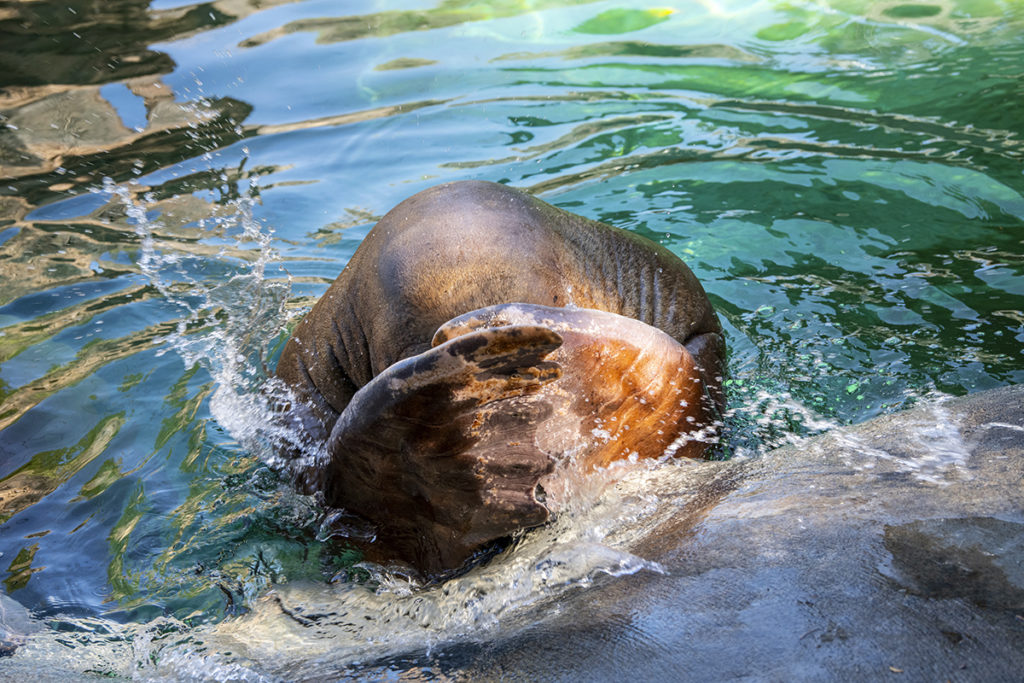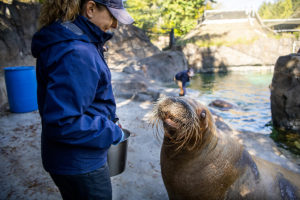
Cindy Roberts and Sheriden Ploof stood in long rubber boots on the edge of the walrus pool, metal bucket in hand. For the two Point Defiance Zoo & Aquarium staff biologists, it was a bittersweet moment. Basilla and Kulusiq, the zoo’s two female walruses, were leaving for a new home in sunny San Diego – and this was one of the last training sessions they’d have before saying goodbye.
“Ready?” asked Roberts.
“Ready,” answered Ploof, hoisting her pail.
“Kulu!” “Basa!” they called, “Deck!” And almost in unison the two walruses swam up and shimmied onto the rockwork.
On Cue
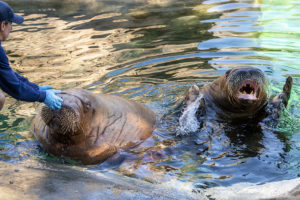
Immediately, the cues came flying.
“Foot!” called Roberts, “Flipper!” called Ploof, and each walrus raised a giant flipper. It looks like a human wave, but it’s actually a great way for keepers to visually check animal health motion each day.
Then came vocalizations.
“Groan!” said both keepers, and each walrus began a low, boomy groan, deep in her throat.
Meanwhile, Basa was in the water and showing off several behaviors that let Ploof see her body condition and range of movement. Since she’s blind, both walrus and human have worked hard to learn cues based on touch, not sight: a hand brushed through whiskers in a circle, for instance, means a spin in the water.
“Some of these cues are just fun, for mental and physical stimulation,” explained Roberts. “The walruses love learning them and it exercises their brain and body.”
Care and Enrichment
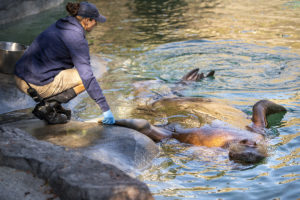
Training is a big part of caring for zoo animals, to give them mental and physical enrichment and allow them to voluntarily participate in their own health care. It’s all done by positive reinforcement: rewarding the asked-for behavior with food or treats and ignoring any other behaviors.
Some behaviors are for daily check-ups or regular routines (like teeth brushing); others help veterinarians give essential medications or take necessary blood samples for diagnosis. Other behaviors, like whistling, groaning, and blowing bubbles, are natural behaviors that walruses use in the wild.
The two walruses are leaving in mid-October for their new home in San Diego to be part of a bigger breeding colony with Dozer, a male walrus who has visited Point Defiance Zoo twice in the past. It’s part of a plan by the Walrus Consortium – zoos and aquariums interested in caring for walruses – to try a different approach to managing the walrus population in human care.
Off to San Diego
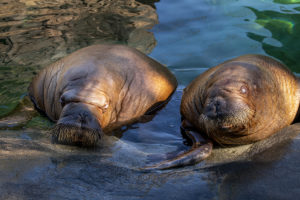
In the wild, walruses breed in huge colonies of hundreds of animals. So accredited U.S. zoos with big walrus habitats are creating “leks” (breeding colonies) for breeding males, while Point Defiance and other zoos will provide homes to non-breeding animals. Two younger males will arrive in Tacoma later this year.
“We collaborate with other zoos to best manage the animals in our care and connect guests to their species in the wild,” says Malia Somerville, curator of marine mammals and birds. “Breeding is an important part of that.”
And keepers, who have worked with 36-year-old Basa and 25-year-old Kulu since they arrived in 2006 and 2016 respectively, are also saying goodbye.
By the pool, Roberts and Ploof gave one final cue for the day.
“Hide!” cried Roberts. Kulu instantly covered her face with both flippers.
Basa, however, didn’t take the cue, as if to say “No, thanks.”
“Guess she doesn’t want to do that today,” smiled Ploof. “And that’s okay.”
“Are you done?” asked Roberts, checking her bucket for remaining squid.
“I’m done,” Ploof answered.
Together, they gave the walruses the “all done” signal, then made their way out of the habitat as Basa and Kulu dove down deep.
“We’ll really miss them,” said Roberts. “But they are doing important work for the future of the species.”
